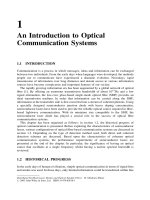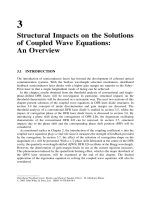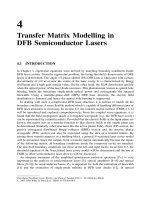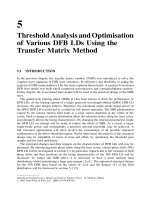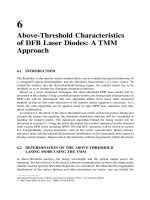Tài liệu Laser điốt được phân phối thông tin phản hồi và các bộ lọc du dương quang P5 pdf
Bạn đang xem bản rút gọn của tài liệu. Xem và tải ngay bản đầy đủ của tài liệu tại đây (406.69 KB, 25 trang )
5
Threshold Analysis and Optimisation
of Various DFB LDs Using the
Transfer Matrix Method
5.1 INTRODUCTION
In the previous chapter, the transfer matrix method (TMM) was introduced to solve the
coupled wave equations in DFB laser structures. Its efficiency and flexibility in aiding the
analysis of DFB semiconductor LDs has been explored theoretically. A general N-sectioned
DFB laser model was built which comprised active/passive and corrugated/planar sections.
In this chapter, the N-sectioned laser model will be used in the practical design of the DFB
laser.
The spatial hole burning effect (SHB) [1] has been known to limit the performance of
DFB LDs. As the biasing current of a single quarterly-wavelength-shifted (QWS) DFB LD
increases, the gain margin reduces. Therefore, the maximum single-mode output power of
the QWS DFB LD is restricted to a relatively low power operation. The SHB phenomenon
caused by the intense electric field leads to a local carrier depletion at the centre of the
cavity. Such a change in carrier distribution alters the refractive index along the laser cavity
and ultimately affects the lasing characteristics. By changing the structural parameters inside
the DFB LD, an attempt will be made to reduce the effect of SHB. As a result, a larger
single-mode power, and consequently a narrower spectral linewidth, may be achieved. A
full structural optimisation will often involve the examination of all possible structural
combinations in the above-threshold regime. On the other hand, the analysis of the structural
design may be simplified, in terms of time and effort, by optimising the threshold gain
margin and the field uniformity.
The structural changes and their impacts on the characteristics of DFB LDs will now be
presented. By introducing more phase shifts along the laser cavity, a three-phase-shift (3PS)
DFB LD will be investigated in section 5.2. In particular, impacts due to the variation of both
phase shifts and their positions on the lasing characteristics of the 3PS DFB LD will be
discussed. To reduce the SHB effect, it is necessary to have a more uniform field
distribution, whilst maintaining a large gain margin ðÁLÞ. The optimised structural design
for the 3PS DFB laser based on the values of ÁL and the flatness (F) of the field
distribution will be discussed in section 5.3 [2].
Distributed Feedback Laser Diodes and Optical Tunable Filters H. Ghafouri–Shiraz
# 2003 John Wiley & Sons, Ltd ISBN: 0-470-85618-1
By changing the height of the corrugation and thus the coupling coefficient along a DFB
laser cavity, a distributed coupling coefficient (DCC) DFB laser can be built. In section 5.4,
the threshold characteristics of this structure will be shown. In particular, effects due to the
variation of the coupling ratio and the position of the corrugation change will be
investigated. To maintain a single-mode oscillation, a single phase shift is introduced
at the centre of the cavity. By changing the value of the phase shift, the combined effect with
the non-uniform coupling coefficient will be presented. Optimised structural combinations
that satisfy both a high gain margin and a low value of flatness will be selected for later use
in the above-threshold analysis.
In section 5.5, the combined effect of both multiple phase shifts and non-uniform coupling
coefficients will be investigated using a DCC þ 3PS DFB laser structure. Finally, a summary
will be presented at the end of this chapter.
5.2 THRESHOLD ANALYSIS OF THE THREE-PHASE-SHIFT
(3PS) DFB LASER
By introducing more phase shifts along the laser cavity, it has been shown [3–5] that the
spatial hole burning effect can be reduced in a 3PS DFB LD which is characterised by a more
uniform internal field distribution. Experimental measurement has been carried out [5] using
a fixed value of phase shift. However, independent changes in the value of phase shift have not
been fully explored. Using the TMM, it was shown in Table 4.1 of Chapter 4 that four transfer
matrices are necessary to determine the threshold condition of 3PS DFB lasers. In Fig. 5.1, a
schematic diagram of the 3PS DFB laser structure is shown. In the figure,
2
,
3
and
4
represent phase shifts and the length of each smaller section is labelled L
j
ð j ¼ 1; 2Þ. In the
analysis, zero facet reflection at the laser facets is assumed. Following the formulation of the
transfer matrix method, the overall transfer matrix of the 3PS DFB laser becomes:
Y z
5
j z
1
ðÞ¼F
ð4Þ
F
ð3Þ
F
ð2Þ
F
ð1Þ
¼
y
11
z
5
j z
1
ðÞy
12
z
5
j z
1
ðÞ
y
21
z
5
j z
1
ðÞy
22
z
5
j z
1
ðÞ
ð5:1Þ
where F
ð jÞ
ð j ¼ 1 to 4) corresponds to the transfer matrix of each smaller section. For a
mirrorless cavity, the threshold condition can be found by solving the following equation
y
22
z
5
j z
1
ðÞ¼0 ð5:2Þ
Figure 5.1 Schematic diagram showing a 3PS DFB LD.
124
THRESHOLD ANALYSIS AND OPTIMISATION OF VARIOUS DFB LD
S
Using a numerical approach such as Newton–Raphson’s method [6] for analytical complex
equations, the threshold equation above may be solved. Figure 5.2 shows the resonance
modes obtained from a symmetrical 3PS DFB laser where
2
¼
3
¼
4
¼ =2 and L
1
¼ L
2
are assumed. For comparison purposes, results obtained from a mirrorless conventional DFB
laser and a single =2 phase-shifted DFB laser are also included. In all three cases, the
coupling coefficient and the overall laser cavity length L are fixed at 40 cm
À1
and 500 mm,
respectively. Oscillation modes at the Bragg wavelength are found for both the single =2
and a 3PS DFB structure. However, the Bragg resonance mode of the 3PS DFB laser does
not show the smallest amplitude threshold gain. Instead, degenerate oscillation occurs since
it is shown that both the À1 and þ1 modes share the same value of amplitude threshold gain.
It is interesting to see how a single =2 phase shift enables SLM operation whilst multi-
mode oscillation occurs in the case where there are three phase shifts, i.e. f=2;=2;=2g.
The pair of braces fgused hereafter will indicate a phase combination in the 3PS structure,
that is f
2
;
3
;
4
g.
5.2.1 Effects of Phase Shift on the Lasing Characteristics
In order that stable SLM operation can be achieved in the 3PS DFB laser, one must change
the value or the position of the phase shift. Figure 5.3 shows oscillation modes of various
3PS DFB laser structures. In the analysis, the values of the three phase shifts are assumed to
be equal and the phase shift positions are the same as in Fig. 5.2. A shift of resonance mode
can be seen when all phase shifts change from =2to2=5. The þ1 mode which
demonstrates the smallest amplitude threshold gain will become the lasing mode after lasing
Figure 5.2 Resonance modes of various DFBs that include: (a) a conventional DFB laser diode; (b) a
single QWS DFB laser diode; (c) a three /2-phase-shifted DFB laser diode.
THRESHOLD ANALYSIS OF THE THREE-PHASE-SHIFT (3PS) DFB LASER
125
threshold is reached. On the other hand, the À1 mode will become the lasing mode when the
three phase shifts change from =2to3=5. With all three phase shifts displaced from the
usual =2 values, SLM can be achieved in the 3PS DFB LD.
5.2.2 Effects of Phase Shift Position (PSP) on the Lasing Characteristics
The 3PS DFB laser structure we have discussed so far is said to be symmetrical. For a cavity
length of L, the position of phase shifts is assumed in such a way that L
1
¼ L
2
¼ L=4. To
investigate the effect of the phase shift position (PSP) on the threshold characteristics, a
position factor is introduced such that
¼
L
1
L
1
þ L
2
¼
2L
1
L
ð5:3Þ
where
3
is assumed to be located at the centre of the cavity. Using the above equation, it
should be noted that both ¼ 0 and ¼ 1 correspond to a single-phase-shifted DFB laser
structure.
In Fig. 5.4, the variation of the amplitude threshold gain is shown with the position factor
for different values of normalised coupling coefficient L. All the phase shifts are fixed at
2
¼
3
¼
4
¼ =3. At a fixed value of , the figure shows a decrease in amplitude
threshold gain as the L value increases. Along the curve L ¼ 1:0, discontinuities at
¼ 0:12 and ¼ 0:41 indicate possible changes in the oscillation mode.
Figure 5.3 Resonance modes in various 3PS DFBs that include: (a) a f=2, =2, =2g 3PS DFB
laser; (b) a f2=5; 2=5; 2=5g 3PS DFB laser; (c) a f3=5; 3=5; 3=5g laser.
126
THRESHOLD ANALYSIS AND OPTIMISATION OF VARIOUS DFB LD
S
Figure 5.5 The variation of detuning coefficient with respect to the phase shift position for coupling
coefficient .
Figure 5.4 The change of amplitude gain with respect to the phase shift position for different values
of coupling coefficient .
Such a change in oscillation is confirmed when the relationship between the detuning
coefficient and the position factor is shown in Fig. 5.5. Along L ¼ 1:0, it can be seen that
the À1 mode remains as the oscillation mode when increases from zero. When ¼ 0:12 is
reached, however, a sudden change of oscillation mode is observed. Similar mode jumping
occurs at ¼ 0:41. When the PSP shifts, there is a continuous change in the resonant cavity
formed by the DFB laser such that the actual lasing mode may alter. At ¼ 0:77, it is
interesting to see how all L values converge to the same lasing wavelength. It appears that
at this particular phase shift position, the effect of the variation of L is irrelevant and the
lasing characteristic depends on the presence of the =3 phase shifts.
5.3 OPTIMUM DESIGN OF A 3PS DFB LASER STRUCTURE
A complete structural optimisation of MPS DFB lasers cannot be achieved without analysing
the above-threshold performances. This involves solving the carrier rate equation, which is a
fairly complex process and needs intensive computation. On the other hand, it is believed
that the complexity of the structural design in the 3PS DFB laser can be reduced by
optimising the threshold amplitude gain difference and the flatness of field distribution.
Hence, we can simply concentrate on those structures satisfying these design criteria. For a
high-performance DFB LD, both a stable single-mode oscillation and a uniform field
distribution are important to prevent LDs from being affected by the spatial hole burning
effect. In our analysis, DFB laser structures having a high gain margin ðÁLÞ are
considered, whilst the spatial hole burning effect is included by analysing the corresponding
effects on field uniformity. Reports by Kimura and Sugimura [3– 4] as well as Ogita et al. [5]
suggested that the lasing characteristics are strongly influenced by both and . To maintain
a stable SLM oscillation, and consequently improve the performance of the spectral
linewidth, these structural parameters need to be optimised.
5.3.1 Structural Impacts on the Gain Margin
To achieve a stable laser source that oscillates at a single longitudinal mode, it is important
that there is a gain margin ÁL > 0:25½1. In the analysis, we assumed the length of the
laser L to be 500 mm. For a 3PS DFB LD, Fig. 5.6 shows the relationship between the gain
margin and the phase shift in a symmetrical structure for different values of L ranging
from 1 to 3. The position factor ¼ 0:5 corresponds to the case where L
1
¼ L
2
¼ L=4. In all
cases, the degenerate oscillations occur at ¼ 0, =2 and , and the distributions of gain
margins are symmetrical with respect to ¼ =2. It is also shown that the variation of L
has little effect on the gain margin of the 3PS laser structure. Along the line L ¼ 1, it is
found that a stable laser having ÁL > 0:25 can be obtained provided that 47
<<73
or
107
<<133
.
In Fig. 5.7, a contour map is shown that relates the gain margin to the values of phase
shifts in three-phase-shift
2
;
3
;
4
fg
DFB LDs. In the calculations, L ¼ 2 and ¼ 0:5 are
assumed. The phase shift
3
introduced at the centre of the cavity is separated from the rest
so that its value can be selected independently. Other phase shifts are assumed to be equal as
2
¼
4
¼
side
. As stated earlier, to satisfy the requirement of ÁL > 0:25,
side
must either
be greater than 105
or less than 80
if
3
can be varied freely between 0 and . A maximum
128
THRESHOLD ANALYSIS AND OPTIMISATION OF VARIOUS DFB LD
S
Figure 5.6 Variation of the gain margin versus the phase shift for different coupling coefficients.
Figure 5.7 Relationship between the gain margin ÁL and phase shifts for a 3PS DFB laser diode.
value of ÁL ¼ 0:73 is obtained at f0;=2; 0g and f; =2;g which corresponds to a
single =2-phase-shifted DFB laser.
The variation of ÁL with respect to the position factor is shown in Fig. 5.8. In this
figure, the values of phase shifts are equal (i.e.
2
¼
3
¼
4
¼ ) and three different sets of
results are calculated with ¼ =2, 2=5 and =3. By changing the values of the phase
shifts, ÁL also changes for each particular value of . At a fixed phase shift ¼ =2 (solid
line), it is shown that a non-zero value of gain margin is observed where <0:13 and
>0:725. As approaches zero, the phase shifts
2
and
4
move towards the laser facets
and their contributions become less influential. Also, as approaches unity, both
2
and
4
move towards the central phase shift
3
. In this case, the 3PS laser structure is reduced to a
single-phase-shifted structure and the lasing characteristic is described by an effective phase
shift of
eff
%
2
þ
3
þ
4
.
Figure 5.9 shows the dependence of ÁL upon for different values of L. In the
analysis, all phase shifts are assumed to be identical (i.e. ¼ =3). From this figure, it is
clear that L has little effect on ÁL in 3PS DFB lasers.
5.3.2 Structural Impacts on the Uniformity of the Internal Field Distribution
In this section, the structural impact on the internal field distribution will be discussed. To
quantify the uniformity of the field distribution, it was shown in Chapter 3 that the flatness
Figure 5.8 Variation of the gain margin versus for various 3PS DFB laser diode structures.
130
THRESHOLD ANALYSIS AND OPTIMISATION OF VARIOUS DFB LD
S
(F) of the internal field of a general N-sectioned DFB laser cavity is defined as
F ¼
1
L
Z
z
Nþ1
z
1
ðIðzÞÀI
avg
Þ
2
dz ð5:4Þ
where IðzÞ is the electric field intensity along the longitudinal axis and I
avg
is its average
value. In the above equation, a zero value of F corresponds to a completely uniform
field.
In order to minimise the effects of longitudinal spatial hole burning, it has been shown
experimentally ½1; 7 that a DFB laser cavity with F < 0:05 is necessary for stable SLM
oscillation. To optimise the structural design of 3PS DFB lasers, F < 0:05 will be used as
one of the design criteria. In order to evaluate the flatness of the internal field distribution,
the threshold equation of the 3PS DFB laser needs to be solved first. The normalised
amplitude threshold gain
th
L and the normalised detuning coefficient
th
L of the lasing
mode are then used to determine the field distribution. In our analysis, a 500 mm long DFB
laser is subdivided into a substantial number of small sections with equal length. From the
output of each transfer matrix, both the forward and the backward propagating electric
fields can be determined, and the electric field intensity at an arbitrary position z
0
is found to
be
Iðz
0
Þ¼ E
R
ðz
0
Þ
jj
2
þ E
S
ðz
0
Þ
jj
2
ð5:5Þ
Figure 5.9 Variation of the gain margin versus for different coupling coefficients.
OPTIMUM DESIGN OF A 3PS DFB LASER STRUCTURE
131
In Fig. 5.10, the internal field distributions of three different structures are shown. These
structures include a conventional mirrorless, a single =2-phase-shifted and a three-phase-
shift f=3;=3;=3g DFB laser. All the electric field distributions have been normalised so
that the intensity at the laser facets is unity. It can be seen that the single =2-phase-shifted
DFB laser has a flatness value of F ¼ 0:301. Such a high value of F (which means that the
field is highly non-uniform) induces a local carrier escalation near the centre of the cavity
after the laser threshold is reached, consequently affecting the single-mode stability of the
laser device. With three phase shifts incorporated into the cavity, the intensity distribution
spreads out and the overall distribution becomes more uniform (see dashed line with
F ¼ 0:012Þ. By optimising the values and the positions of the phase shifts with respect to the
flatness, a 3PS DFB laser can maintain a uniform field distribution even at a high value of
L, which is necessary to reduce the spectral linewidth of the laser.
The effect of on F is shown in Fig. 5.11 for different combinations of L. When small
values of L ð< 1:5Þ are used, the field intensity distribution becomes less uniform when the
phase shifts
2
and
4
shift towards the laser facets (i.e. as tends to 0). As the optical
feedback becomes stronger with increasing L, the field intensity distribution becomes more
intense near the centre of the laser cavity where is found to be about 0.77.
The contour map shown in Fig. 5.12 can be used to optimise the value of phase shifts with
respect to F. In a similar way to Fig. 5.7, the central phase shift
3
is used as the x-axis and
other phase shifts are represented in the y-axis. In this figure, all phase combinations with
F < 0:05 form a ribbon shape stretching from the lower left-hand corner to the upper right-
hand corner of the contour. The worst case, which leads to the largest value of F, can be
Figure 5.10 Field distribution in various DFB laser diode structures.
132
THRESHOLD ANALYSIS AND OPTIMISATION OF VARIOUS DFB LD
S


